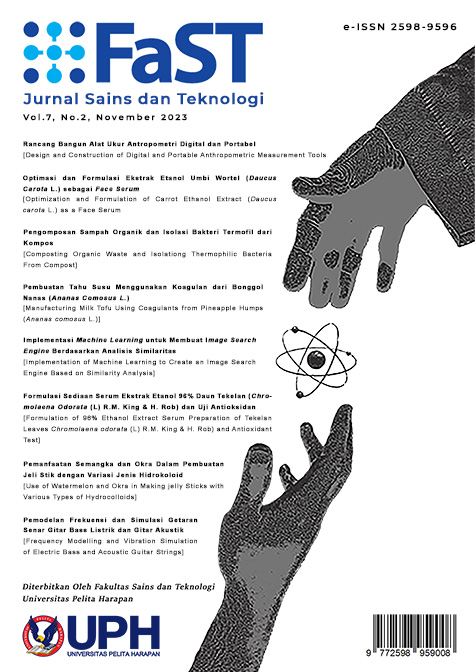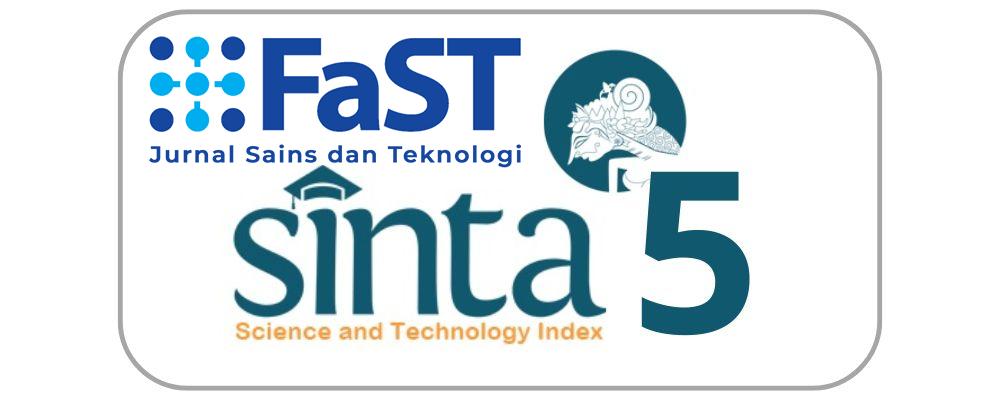PEMANFAATAN SEMANGKA DAN OKRA DALAM PEMBUATAN JELI STIK DENGAN VARIASI JENIS HIDROKOLOID [USE OF WATERMELON AND OKRA IN MAKING JELLY STICKS WITH VARIOUS TYPES OF HYDROCOLLOIDS]
DOI:
https://doi.org/10.19166/jstfast.v7i2.7601Keywords:
carrageenan, konjac, okra, pectin, watermelonAbstract
Jelly is food product in semi-solid form derived from fruit or vegetable juices with the addition of gelling agent. Jelly sticks are easy to eat, carry around and loved by the public. In this research, watermelon and okra were used as jelly’s ingredients because these two ingredients have many health benefits The use of watermelon can also mask the unpleasant aroma and taste of okra. The type of hydrocolloid as gelling agent is an important factor in making jelly stick because it can influence the texture of jelly. The aim of this research was to determine the organoleptic, physic and chemical characteristics of the best jelly stick based on selected ratio of watermelon:okra and type of gelling agent. The treatment factors of jelly included ratio of water melon and okra (60:40, 50:50, 40:60) and the types of gelling agent (carrageenan, carrageenan:konjac, carrageenan:pectin). The best jelly stick was jelly made from a ratio of watermelon and okra 60:40 with a carrageenan:konjac as gelling agent. This jelly had the closest texture to jelly stick commercial with springiness of 0,95 ± 0,01 and cohesiveness of 0,70 ± 0,02. It had °Hue value 22,34 ± 0,97 as a red color, chewy texture, slightly preferred color and neutral overall preference from the panelist. The best jelly stick also had IC50 value of 82226,96 ± 6297,9 ppm, total phenolics of 0,157 ± 0,01 mg GAE/ml, total flavonoids of 0,022 ± 000 mg QE /ml and food fiber content 2,885g/100g.Bahasa Indonesia Abstract:
Jeli merupakan produk pangan dalam bentuk semi padat yang berasal dari sari buah atau sayur dengan penambahan bahan pembentuk gel. Jeli stik mudah untuk dikonsumsi, dibawa bepergian serta banyak disukai masyarakat. Pada penelitian ini digunakan semangka dan okra sebagai bahan baku karena kedua bahan ini memiliki banyak manfaat kesehatan. Penggunaan buah semangka juga dapat menutupi aroma dan rasa khas okra yang kurang disukai. Jenis hidrokoloid sebagai gelling agent merupakan faktor penting dalam pembuatan jeli karena mempengaruhi teksturnya. Tujuan penelitian ini adalah menentukan karakteristik organoleptik, fisik, kimia jeli stik terbaik berdasarkan rasio semangka:okra dan jenis gelling agent terpilih. Faktor perlakuan pada jeli adalah rasio semangka dan okra (60:40, 50:50, 40:60) serta jenis gelling agent (karagenan, karagenan:konjak, dan karagenan:pektin). Jeli stik terbaik adalah jeli dengan rasio semangka dan okra 60:40 dengan jenis gelling agent karagenan:konjak. Jeli ini memiliki tekstur paling mendekati jeli stik komersial dengan springiness sebesaar 0,95 ± 0,01 dan cohesiveness sebesar 0,70 ± 0,02. Jeli ini memiliki nilai °Hue sebesar 22,34 ± 0,97 sebagai warna merah, tekstur kenyal, warna yang agak disukai dan kesukaan keseluruhan yang netral dari panelis. Jeli stik terbaik juga memiliki nilai IC50 sebesar 82226,96 ± 6297,9 ppm, total fenolik sebesar 0,157 ± 0,01 mg GAE/ml, total flavonoid sebesar 0,022 ± 000 mg QE /ml dan kadar serat pangan 2,885g/100g.
References
Adiaprana, R., Ma'ruf, W. F., & Anggo, A. D. (2016). Kajian kualitas stabilitas emulsi semi refined carrageenan (src) dan tepung konjak pada sosis ikan nila (Oreochromis sp.). Jurnal Pengolahan dan Bioteknologi Hasil Perikan-an, 5(1), 23-27.
Agustina, E. (2017). Uji Aktivitas senyawa antioksidan dari ekstrak daun tiin (Ficus carica Linn) dengan pelarut air, metanol dan campuran metanol-air. KLOROFIL: Jurnal Ilmu Biologi dan Terapan, 1(1), 34-47. http://dx.doi.org/10.30821/kfl:jibt.v1i1.1240
Ahmad, S., Butt, M. S., Pasha, I., & Sameen, A. (2015). Quality of processed cheddar cheese as a function of emulsifying salt replaced by κ-carrageenan. International Journal of Food Properties, 19(8), 1874-1883. https://doi.org/10.1080/10942912.2015.1085396
Ahmed, M., Ji, M., Qin, P., Gu, Z., Liu, Y., Sikandar, A., Iqbal, M. F., & Javeed, A. (2019). Phytochemical screening, total phenolic and flavonoids contents and antioxidant activities of Citrullus colocynthis L. and Cannabis sativa L. Applied Ecologyand Environmental Research, 17, 6961-6979. https://doi.org/10.15666/aeer/1703_69616979
Akesowan, A. (2014). Optimization of textural properties of konjac gels formed with κ-carrageenan or xanthan and xylitol as ingredients in jelly drink processing. Journal of Food Processing and Preservation, 39(6), 1735-1743. https://doi.org/10.1111/jfpp.12405
Amerine, M. A., Pangborn, R. M., & Roessler, E. B. (2013). Principles of Sensory Evaluation of Food. Elsevier.
Ardiansyah, G., Hintono, A., & Pratama, Y. (2019). Karakteristik fisik selai wortel (Daucus carota l.) dengan penambahan tepung porang (Amorphophallus oncophyllus) sebagai bahan pengental. Jurnal Teknologi Pangan, 3(2), 175-180. https://doi.org/10.14710/jtp.2019.23520
Association of Official Analytical Chemistry (AOAC). (2005). Official Method of Analysis (18th ed). AOAC International. Gaithersburg
Aziz, T., Johan, M. E. G., & Sri, D. (2018). Pengaruh jenis pelarut, temperatur, dan waktu terhadap karakterisasi pektin hasil ekstraksi dari kulit buah naga (Hylocereus polyrhizus). Jurnal Teknik Kimia, 24(1), 17-27. https://doi.org/10.36706/jtk.v24i1.413
Azni, I. N., Amelia, J. R., Andriantini, A., & Rismawati, A. (2019). Karakteristik kimia minuman okra dengan penambahan daun stevia dan ekstrak jahe. Jurnal Agroindustri Halal, 5(1), 1-8. https://doi.org/10.30997/jah.v5i1.1467
Berns, R. S. (2019). Billmeyer and Saltzman’s Principles of Color Technology (4th ed.). John Wiley & Sons Inc. https://doi.org/10.1002/9781119367314
Chrisella, A., Kusumawati, N., & Suseno, T. I. P. (2015). Pengaruh perbedaan penambahan rumput laut eucheuma cotonii dan gelatin dengan berbagai konsentrasi terhadap sifat fisikokimia dan organoleptik permen jelly rumput laut. Jurnal Teknologi Pangan dan Gizi, 14(1), 38-45.
CP Kelco. (2011). Product data sheet: GENU pectin type LM-101 AS. CP Kelco U.S., Inc.
Eveline, Santoso, J., & Widjaja, I. (2011). Kajian konsentrasi dan rasio gelatin dari kulit ikan patin dan kappa karagenan pada pembuatan jeli. Jurnal Pengolahan Hasil Perikanan Indonesia, 14(2), 98-105.
Faisal, H. (2019). Uji Aktivitas antioksidan ekstrak etanol buah okra (Abelmoschus esculentus L. Moench) dengan metode DPPH (1, 1-difenil-2-pikrilhidrazil) dan metode ABTS (2, 2-azinobis-(3-ethylbenzothiazoline-6-sulfonic acid). Ready Star, 2(1), 1-5.
Garrido, J. I., Lozano, J. E., & Genovese, D. B. (2014). Effect of formulation variables on rheology, texture, colour, and acceptability of apple jelly: Modelling and optimization. LWT-Food Science and Technology, 62(1), 325-332. https://doi.org/10.1016/j.lwt.2014.07.010
Hamsina, Hasani R., & Irfan. (2019). Optimasi proses ekstraksi senyawa likopen dari buah semangka dengan menggunakan variasi pelarut. Prosiding Seminar Nasional Penelitian & Pengabdian Kepada Masyarakat, 4, 59-63.
Han, W., Meng, Y., Hu, C., Dong, G., Qu, Y., Deng, H., & Guo, Y. (2017). Mathematical model of Ca2+ concentration, pH, pectin concentration and soluble solids (sucrose) on the gelation of low methoxyl pectin. Food Hydrocolloids, 66, 37-48. https://doi.org/10.1016/j.foodhyd.2016.12.011
Hasanah, N., Hidayah, I. N., & Muflihati, I. (2019). Karakteristik jelly drink seledri dengan variasi konsentrasi karagenan dan agar. Journal of Food and Culinary, 2(1), 17-26. https://doi.org/10.12928/jfc.v2i1.1436
Herawati, H. (2018). Potensi hidrokoloid sebagai bahan tambahan pada produk pangan dan nonpangan bermutu. Jurnal Litbang Pertanian, 37(1), 17-25. https://doi.org/10.21082/jp3.v37n1.2018.p17-25
Kaya, A. O. W., Suryani, A., Santoso, J., & Rusli, M. S. (2015). Karakteristik dan struktur mikro gel campuran semirefined carrageenan dan glukomanan. Jurnal Kimia dan Kemasan, 37(1), 19-28. http://dx.doi.org/10.24817/jkk.v37i1.1808
Kuncari, E. S., Iskandarsyah, & Praptiwi. (2014). Evaluasi, uji stabilitas fisik dan sineresis sediaan gel yang mengandung minoksidil, apigenin, dan perasan herba seledri (Apium graveolens L.). Buletin Penelitian Kesehatan, 42(4), 213-222.
Mariani, S., Rahman, N., & Supriadi, S. (2018). Uji aktivitas antioksidan ekstrak buah semangka (Citrullus lanatus). Jurnal Akademika Kimia, 7(2), 96-101. https://doi.org/10.22487/j24775185.2018.v7.i2.10401
Novidahlia, N., Rohmayanti, T., & Nurmilasari, Y. (2019). Karakteristik fisikokimia jelly drink daging semangka, albedo semangka, dan tomat dengan penambahan karagenan dan tepung porang (Amorphophallus muelleri Blume). Jurnal Agroindustri Halal, 5(1), 57-66. https://doi.org/10.30997/jah.v5i1.1694
Nurlin, L. A. (2017). Kandungan serat pangan pada minuman jeli okra hijau Abelmoschus esculentus) dan stroberi (Fragaria ananassa) [Bachelor’s Thesis]. Institut Pertanian Bogor, Bogor, Indonesia.
Phillips, G. O., & Williams, P. A. (2009). Handbook of hydrocolloids (2nd ed.). Woodhead Publishing Limited.
Purwanto, D., Bahri, S., & Ridhay, A. (2017). Uji aktivitas antioksidan ekstrak buah purnajiwa (Kopsia arborea Blume.) dengan berbagai pelarut. KOVALEN: Jurnal Riset Kimia, 3(1), 24-32. https://doi.org/10.22487/j24775398.2017.v3.i1.8230
Rubio-Arraez, S., Benavent, C., Ortolá, M. D., & Castelló, M. L. (2018). Influence of low glycaemic index sweeteners on antioxidant, sensory, mechanical, and physicochemical properties of a watermelon jelly. Journal of Food Quality, 2018, 8412017. http://dx.doi.org/10.1155/2018/8412017
Rulaningtyas, R., Suksmono, A. B., Mengko, T. L. R., & Saptawati, G. A. P. (2015). Segmentasi citra berwarna dengan menggunakan metode clustering berbasis patch untuk identifikasi Mycobacterium tuberculosis. Jurnal Biosains Pascasarjana, 17(1), 19-25. https://doi.org/10.20473/jbp.v17i1.2015.19-25
Salim, M., Dharma, A., Mardiah, E., & Oktoriza, G. (2017). Pengaruh kandungan antosianin dan antioksidan pada proses pengolahan ubi jalar ungu. Jurnal Zarah, 5(2), 7-12. https://doi.org/10.31629/zarah.v5i2.209
Senet, M. R. M., Raharja, I. G. M. A. P., Darma, I. K. T., Prastakarini, K. T., Dewi, N. M. A., & Parwata, I. M. O. A. (2018). Penentuan kandungan total flavonoid dan total fenol dari akar kersen (Mutingia calabura) serta aktivitasnya sebagai antioksidan. Jurnal Kimia, 12(1), 13-8. https://doi.org/10.24843/JCHEM.2018.v12.i01.p03
Thakre, G., & Barse, A. (2018). Development of herbal jelly (with Hibiscus rosa sinensis and rose petals). Journal of Medicinal Plants Studies, 6(6), 30-32.
Utomo, B. S. B., Darmawan, M., Hakim, A. R., & Ardi, D. T. (2014). Sifat fisikokimia dan evaluasi sensori permen jeli yang terbuat dari k-karaginan dan konjak dengan rasio yang berbeda. Squalen Bulletin of Marine & Fisheries Postharvest & Biotechnology, 9(1), 25-34. https://doi.org/10.15578/squalen.93
Downloads
Published
Issue
Section
License
“Authors who publish with this journal agree to the following terms:
1) Authors retain copyright and grant the journal right of first publication with the work simultaneously licensed under a Creative Commons Attribution License (CC-BY-SA 4.0) that allows others to share the work with an acknowledgement of the work's authorship and initial publication in this journal.
2) Authors are able to enter into separate, additional contractual arrangements for the non-exclusive distribution of the journal's published version of the work (e.g., post it to an institutional repository or publish it in a book), with an acknowledgement of its initial publication in this journal.
3) Authors are permitted and encouraged to post their work online (e.g., in institutional repositories or on their website). The final published PDF should be used and bibliographic details that credit the publication in this journal should be included.”





